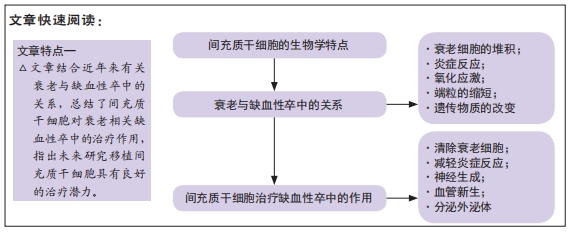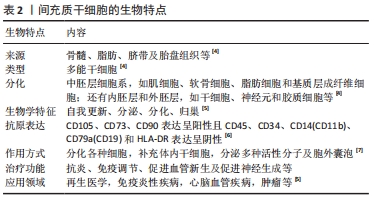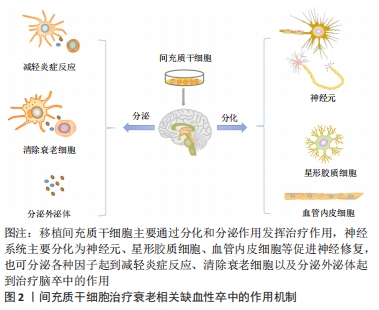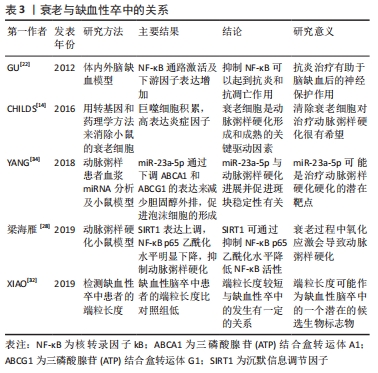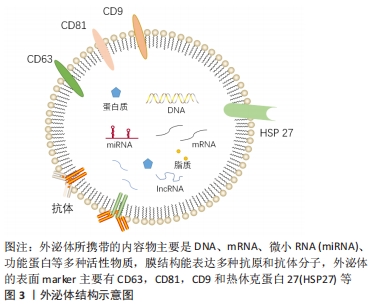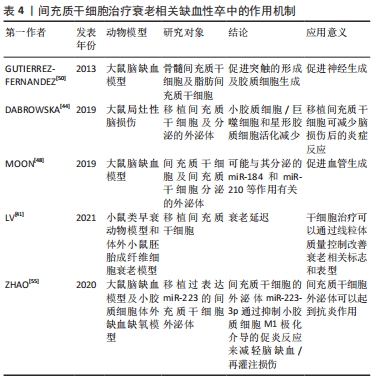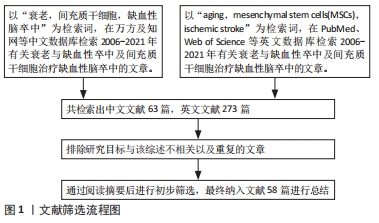[1] SIFAT AE, VAIDYA B, ABBRUSCATO T J. Blood-brain barrier protection as a therapeutic strategy for acute ischemic stroke. AAPS J. 2017;19(4):957-972.
[2] LIU D, XU L, ZHANG X, et al. Snapshot:Implications for mTOR in Aging-related Ischemia/Reperfusion Injury. Aging Dis. 2019;10(1):116-133.
[3] UNGVARI Z, TARANTINI S, DONATO AJ, et al. Mechanisms of vascular aging. Circ Res. 2018;123(7):849-867.
[4] SHERMAN LS, ROMAGANO MP, WILLIAMS SF, et al. Mesenchymal stem cell therapies in brain disease. Semin Cell Dev Biol. 2019;95:111-119.
[5] SONG N, SCHOLTEMEIJER M, SHAH K. Mesenchymal stem cell immunomodulation: mechanisms and therapeutic potential. Trends Pharmacol Sci. 2020;41(9):653-664.
[6] DOEPPNER TR, BAHR M, GIEBEL B, et al. Immunological and non-immunological effects of stem cell-derived extracellular vesicles on the ischaemic brain. Ther Adv Neurol Disord. 2018;11:1277010894.
[7] JAFARI D, SHAJARI S, JAFARI R, et al. Designer exosomes: a new platform for biotechnology therapeutics. BioDrugs. 2020;34(5):567-586.
[8] KIRKLAND JL, TCHKONIA T. Cellular senescence: a translational perspective. EBioMedicine. 2017;21:21-28.
[9] ACOSTA J C, BANITO A, WUESTEFELD T, et al. A complex secretory program orchestrated by the inflammasome controls paracrine senescence. Nat Cell Biol. 2013;15(8):978-990.
[10] LI X, DAI Y, SHEN T, et al. Induced migration of endothelial cells into 3D scaffolds by chemoattractants secreted by pro-inflammatory macrophages in situ. Regen Biomater. 2017;4(3):139-148.
[11] LIBBY P, BURING JE, BADIMON L, et al. Atherosclerosis. Nat Rev Dis Primers. 2019; 5(1):56.
[12] OGRODNIK M, EVANS SA, FIELDER E, et al. Whole-body senescent cell clearance alleviates age-related brain inflammation and cognitive impairment in mice. Aging Cell. 2021:e13296.
[13] CHILDS BG, GLUSCEVIC M, BAKER DJ, et al. Senescent cells:an emerging target for diseases of ageing. Nat Rev Drug Discov. 2017;16(10):718-735.
[14] CHILDS BG, BAKER DJ, WIJSHAKE T, et al. Senescent intimal foam cells are deleterious at all stages of atherosclerosis. Science. 2016;354(6311):472-477.
[15] MUNOZ-ESPIN D, SERRANO M. Cellular senescence: from physiology to pathology. Nat Rev Mol Cell Biol. 2014;15(7):482-496.
[16] 姜平,黎健.血管衰老及其机制[J].生物化学与生物物理进展,2014,41(3): 295-304.
[17] MANIEGA SM, VALDES HM, CLAYDEN JD, et al. White matter hyperintensities and normal-appearing white matter integrity in the aging brain. Neurobiol Aging. 2015;36(2):909-918.
[18] 陈祥宁,刘洋,纪俊峰. 清除衰老细胞在衰老与老龄化相关疾病中的研究进展[J].生物化学与生物物理进展,2019,46(12):1150-1161.
[19] LI PH, ZHANG R, CHENG LQ, et al. Metabolic regulation of immune cells in proinflammatory microenvironments and diseases during ageing. Ageing Res Rev. 2020;64:101165.
[20] GONZALEZ H, ELGUETA D, MONTOYA A, et al. Neuroimmune regulation of microglial activity involved in neuroinflammation and neurodegenerative diseases. J Neuroimmunol. 2014;274(1-2):1-13.
[21] LIU LR, LIU JC, BAO JS, et al. Interaction of Microglia and Astrocytes in the Neurovascular Unit. Front Immunol. 2020;11:1024.
[22] GU JH, GE JB, LI M, et al. Inhibition of NF-kappaB activation is associated with anti-inflammatory and anti-apoptotic effects of Ginkgolide B in a mouse model of cerebral ischemia/reperfusion injury. Eur J Pharm Sci. 2012;47(4):652-660.
[23] MA M, UEKAWA K, HASEGAWA Y, et al. Pretreatment with rosuvastatin protects against focal cerebral ischemia/reperfusion injury in rats through attenuation of oxidative stress and inflammation. Brain Res. 2013;1519:87-94.
[24] 赵滔.赭曲霉毒素A诱导HEK293T细胞氧化应激及自噬研究[D].遵义:遵义医学院,2017.
[25] WU P, ZHOU Y M, ZENG F, et al. Regional brain structural abnormality in ischemic stroke patients: a voxel-based morphometry study. Neural Regen Res. 2016;11(9):1424-1430.
[26] RAZI S, COGGER VC, KENNERSON M, et al. SIRT1 polymorphisms and serum-induced SIRT1 protein expression in aging and frailty: the CHAMP study. J Gerontol A Biol Sci Med Sci. 2017;72(7):870-876.
[27] HAN Y, LUO H, WANG H, et al. SIRT1 induces resistance to apoptosis in human granulosa cells by activating the ERK pathway and inhibiting NF-kappaB signaling with anti-inflammatory functions. Apoptosis. 2017;22(10):1260-1272.
[28] 梁海雁,王世喜.过表达SIRT1对动脉粥样硬化小鼠炎症反应的治疗效果[J].解剖学研究,2019,41(6):513-517.
[29] UTANI K, FU H, JANG SM, et al. Phosphorylated SIRT1 associates with replication origins to prevent excess replication initiation and preserve genomic stability. Nucleic Acids Res. 2017;45(13):7807-7824.
[30] FUSTER JJ, ANDRES V. Telomere biology and cardiovascular disease. Circ Res. 2006;99(11):1167-1180.
[31] SAMANI N J, VAN DER HARST P. Biological ageing and cardiovascular disease. Heart. 2008;94(5):537-539.
[32] XIAO J, YUAN Q, ZHANG S, et al. The telomere length of peripheral blood cells is associated with the risk of ischemic stroke in Han population of northern China. Medicine (Baltimore). 2019;98(7):e14593.
[33] 李丹青.外周血白细胞端粒长度与大动脉粥样硬化性脑梗死及颈动脉粥样硬化斑块稳定性的相关研究[D].合肥:安徽医科大学,2017.
[34] YANG S, YE ZM, CHEN S, et al. MicroRNA-23a-5p promotes atherosclerotic plaque progression and vulnerability by repressing ATP-binding cassette transporter A1/G1 in macrophages. J Mol Cell Cardiol. 2018;123:139-149.
[35] 张真,廖清池,柳书可,等.微小RNA与血管内皮细胞的衰老关系研究进展[J].中华老年心脑血管病杂志,2018,20(12):1327-1329.
[36] 王瑞彤,闫昕,陈辉,等.miR-155在胶质瘤干细胞样细胞的表达及临床意义[J].临床神经外科杂志,2019,16(4):277-281.
[37] 宓林,于晓峰,邹健.miRNA对衰老调控的相关研究进展[J].中国老年学杂志, 2014,34(17):5024-5027.
[38] 郑桂纯,赵姝灿,黄丽贞,等.不同来源间充质干细胞条件培养基对内源性衰老细胞作用的比较[J].中国组织工程研究,2019,23(21):3357-3363.
[39] 张勃昕,吉爱红,曹正垚,等.miR-34a对人颌骨骨髓间充质干细胞成骨分化的影响[J].口腔生物医学,2019,10(1):1-5.
[40] 苏路路,管博文,樊飞跃,等.衰老细胞清除剂研究进展[J].中国药理学通报, 2019,35(10):1333-1337.
[41] XU M, PIRTSKHALAVA T, FARR JN, et al. Senolytics improve physical function and increase lifespan in old age. Nat Med. 2018;24(8):1246-1256.
[42] LV M, ZHANG S, JIANG B, et al. Adipose-derived stem cells regulate metabolic homeostasis and delay aging by promoting mitophagy. FASEB J. 2021;35(7): e21709.
[43] GERANMAYEH MH, RAHBARGHAZI R, FARHOUDI M. Targeting pericytes for neurovascular regeneration. Cell Commun Signal. 2019;17(1):26.
[44] AMANTEA D, MICIELI G, TASSORELLI C, et al. Rational modulation of the innate immune system for neuroprotection in ischemic stroke. Front Neurosci. 2015;9:147.
[45] DABROWSKA S, ANDRZEJEWSKA A, STRZEMECKI D, et al. Human bone marrow mesenchymal stem cell-derived extracellular vesicles attenuate neuroinflammation evoked by focal brain injury in rats. J Neuroinflammation. 2019;16(1):216.
[46] YOO SW, CHANG DY, LEE HS, et al. Immune following suppression mesenchymal stem cell transplantation in the ischemic brain is mediated by TGF-beta. Neurobiol Dis. 2013;58:249-257.
[47] 张桂芳,杨孟丽,常玉霞,等.骨髓间充质干细胞移植在小鼠脑梗死中的作用机制及对大脑HMGB1水平的影响[J].中国老年学杂志,2020,40(2):387-391.
[48] RYU B, SEKINE H, HOMMA J, et al. Allogeneic adipose-derived mesenchymal stem cell sheet that produces neurological improvement with angiogenesis and neurogenesis in a rat stroke model. J Neurosurg. 2019;132(2):442-455.
[49] MOON GJ, SUNG JH, KIM DH, et al. Application of mesenchymal stem cell-derived extracellular vesicles for stroke:biodistribution and microRNA study. Transl Stroke Res. 2019;10(5):509-521.
[50] SHEIKH AM, YANO S, MITAKI S, et al. A Mesenchymal stem cell line (B10) increases angiogenesis in a rat MCAO model. Exp Neurol. 2019;311:182-193.
[51] GUTIERREZ-FERNANDEZ M, RODRIGUEZ-FRUTOS B, RAMOS-CEJUDO J, et al. Effects of intravenous administration of allogenic bone marrow- and adipose tissue-derived mesenchymal stem cells on functional recovery and brain repair markers in experimental ischemic stroke. Stem Cell Res Ther. 2013;4(1):11.
[52] XIE P, DENG M, SUN QG, et al. Therapeutic effect of transplantation of human bone marrowderived mesenchymal stem cells on neuron regeneration in a rat model of middle cerebral artery occlusion. Mol Med Rep. 2019;20(4):3065-3074.
[53] ZHANG Q, ZHAO Y, XU Y, et al. Sodium ferulate and n-butylidenephthalate combined with bone marrow stromal cells (BMSCs) improve the therapeutic effects of angiogenesis and neurogenesis after rat focal cerebral ischemia. J Transl Med. 2016;14(1):223.
[54] CHAU MJ, DEVEAU TC, GU X, et al. Delayed and repeated intranasal delivery of bone marrow stromal cells increases regeneration and functional recovery after ischemic stroke in mice. BMC Neurosci. 2018;19(1):20.
[55] 罗刘军,祝美珍,陈兰,等.基于“肾-脑髓-干细胞”轴探讨缺血性卒中及神经再生[J].辽宁中医药大学学报,2020,22(3):104-107.
[56] ZHAO Y, GAN Y, XU G, et al. Exosomes from MSCs overexpressing microRNA-223-3p attenuate cerebral ischemia through inhibiting microglial M1 polarization mediated inflammation. Life Sci. 2020,260:118403.
[57] ZHENG B, von SEE MP, YU E, et al. Quantitative magnetic particle imaging monitors the transplantation, biodistribution, and clearance of stem cells in vivo. theranostics. 2016;6(3):291-301.
[58] 钱楠楠,张潜,杨睿,等.间充质干细胞治疗脊髓损伤:细胞治疗及联合新药和生物材料[J].中国组织工程研究,2021,25(13):2114-2120.
|
